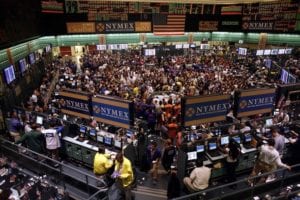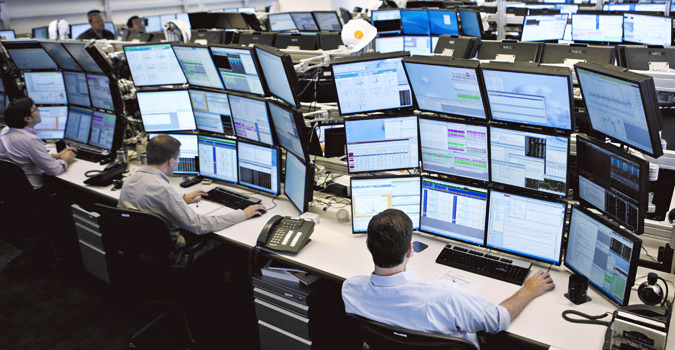Long story short: Most prop trading shops start with traders who got lucky for a while and convinced themselves they are professional traders. As for my experience, my boss was a floor trader and he was one of the best. I learned a lot and made some rookie mistakes due to ego among other young jackass mistakes. Moral of the story – prop shops can be a great place to learn but most are just a gamble. Also, when confronted with the decision, check your ego and go for the experience/education instead of money when you’re younger.
Here’s the long story…
My first job out of undergrad was at a proprietary trading shop, Flucktrading (FT), located in the New York Mercantile Exchange (NYMEX). A little background on prop trading and the NYMEX first: proprietary trading is when a firm trades its own money in an effort to make profit for itself. This is in contrast with buy-side asset management (hedge funds, mutual funds) where the firm trades clients’ money to generate a profit for the clients while collecting management fees, or sales and trading (mostly at bulge bracket banks) where the firm makes trades for the buy-side in order to generate commissions. Of course, banks used to engage in quite a bit of prop trading within S&T, but that’s a longer story as to why S&T is as good as dead.
As for the NYMEX, it was the center of trading in commodities such as oil, gold, silver, and cotton; now it is a deserted office building down the block from the World Trade Center. The last time open outcry/floor trading was significant was the mid-2000s. For those unfamiliar, here is a clip of pit trading from the classic, Trading Places (this took place in the basement of one of the Twin Towers).



Back to prop trading[i] and what makes it tick (skip down a few paragraphs to “Finally back to…” if you don’t care for a background in prop trading). Let’s look at 3 different approaches to (try to) make money in prop trading. The founder and source of all of FT’s capital was the boss, Fonny. His bread and butter was trading in the pits, and this is the only approach to prop trading which we’ll describe that no longer exists. Essentially it is daytrading; and before OTC/computer trading, trading in the pits dictated market prices. Big customer orders would come through brokerage firms whose traders would (inadvertently) telegraph large orders which would allow “local” pit traders, such as Fonny, to capitalize “making markets” on them. It’s kind of like front-running except you have no client. This is quite an exaggeration of the simplicity, but it sets the premise of pit traders having access to a lot more information than others. The main point here is that it was RELATIVELY easy to make money in the pits. To neutralize an influx of millionaires, it was very expensive to get a seat on the exchange. This seat would grant access to trading in the pits.
While Fonny was a complete dick, he was very smart and a great trader who could trade 100’s of contracts simultaneously between dozens of futures spreads (e.g. buying futures contracts for March delivery while selling the equivalent of April). He made $15-20mm in 2006, probably the last year that NYMEX floor trading was relevant. Chicago Mercantile Exchange (CME) bought them out a year or two later….and now open outcry is history.
Another approach to prop trading is driven by fundamentals. Let’s visit fundamentals via commodities, since we hear about equities all too often. Commodity fundamentals dwindle down to supply and demand, which characterizes trading of all instruments of course. By definition though, commodities are in constant supply and demand for consumption, utilization, or storage. Gold of course is a commodity but more of a currency or holder of value than the common resource commodity. Think of oil, natural gas, corn, wheat, cocoa, sugar, copper, or live cattle here. Like Gordon Gekko says himself, the most valuable commodity is information…and that applies even when trading actual commodities. Supply for different commodities is dictated by company production, exploration, crop production, weather, and many other factors depending on the commodity. Of course, the supply is also dictated or even driven by demand. Demand is also driven by macro and microeconomic factors. Case in point, it’s not that simple to explain, and even harder to make money All in all, commodity shops employ people as diverse as meteorologists, farmers, economists, etc., all to drive fundamental trading.
Technical trading is the third approach to trading. By definition, technical analysis is the study of prices and market data….to determine the direction of securities. It makes no sense and all the sense in the world, and this is by far the easiest to learn and therefore the most common means to trading. Charts are studied with trend-lines, resistance and support levels, volume, candlestick patters, and even something called an ichimoku cloud.
Options could be considered another approach to trading, depending on who you ask. While options are commonly used as a vehicle to establish positions/biases stemming from the approaches described above, they are also used to trade volatility or achieve certain risk/reward objectives. Without delving into an options tutorial, volatility is the main X-factor considered into options trading – option prices and volatility have a positive correlation. So, a trader might buy options in low volatility environments with no direction bias, or sell if a trader thinks volatility will decrease, still having no direction bias.
Finally…back to the story and my experience prop trading at FT. We mainly and sometimes exclusively used options to exercise a bias. Option trading can serve two general purposes, trading volatility and trading for leverage. Flucktrading used options for leverage mainly, and like most traders who do so, myself included, we would definitely not admit this at the time. Option trading does open up predetermined risk/reward scenarios though, and this was a very close second in using options at FT. That being said, options are still one of the most complicated financial instruments to grasp, so I spent all of my summer internship asking questions and studying options because I was blown away by how many more ways one could approach a trade with options. Instead of just buy or sell, there were strangles, butterflies, calendar spreads, back spreads, condors, and countless other combinations.
Like any subject on earth, learning about options trading is not impossible or even that difficult with the right approach. By the time I started at FT full-time out of college, I had learned enough about options that I gained the respect my boss and he was appropriately giving me more responsibility with each step I took to prove my competence. Of course, that’s no excuse to run around calling people (myself mostly as the younger guy) fucking idiots and retarded. Once I got used to it, it was worth the added responsibilities.
The real problem came when Fonny actually entrusted me with going to India to open a trading operation there. I knew that he did not have anyone else willing to go to India, nor did he have some he could trust trading his capital who possessed the appropriate level of trading knowledge. In negotiating compensation, I replied to their lowball of $60k + 2% of profits with something ridiculous like $200k + 10% or even 20% of profit. This went over a few weeks where they purchased my plane tickets, booked a month’s stay at one of the best hotels, and even purchased the little things like a brand new pebble cellphone and Rosetta Stone for Hindi. It came down to the night before my flight was to depart and I rejected $90k + 3-5% of profits. I was asking for $100k and 10%. It was purely my ego which wanted to get back Fonny for being verbally abusive and my immaturity in believing I held the edge because I was the only option. Looking back, I realize haggling for % of profits was silly because 0% of the zero profits made is…zero.
Soon after, I never went to India and got completely sandbagged with a $9k bonus on $36k salary. I was furious because Fonny had refused to tell me my bonus until after I clerked for him for one week on the trading floor, in his clerk’s absence. He probably knew I would quit on the spot once I learned of the spiteful bonus. In the end, I missed an unbelievable opportunity to go to India as a 23-year-old. The only one to blame for the low bonus and missed opportunity was myself. Egos, vengeance, and feelings of entitlement can rarely do good for anyone, let alone an immature 23yr old moron such as yours truly.
Lesson learned: Check your ego 100% of the time as a younger professional. Money is of the least concern, let opportunity be the decision driver. In other words don’t be a dumb jackass like me. Prop shops are a good place to learn about trading because they are right in the middle of it. For the most part, they will allow you to learn faster than other places. Learning how to trade is not learning how to make money though. If the shop doesn’t require capital contributions, then they could be worth it (see endnote). Without a connection though, you’re probably not going to find one of those.
[i] Regarding capital contributions at prop shops. A prop shop’s “own money” sometimes means you have to contribute capital as a trader, and the firm provides leverage on this capital. A prop shop is going to collect a % of your profits and let you take the losses. until you prove you can make money and have made them a lot of money, you won’t their “their money.” The only time it benefits you to join a prop shop that requires capital is when you have a proven money making trading strategy and just need leverage and infrastructure. Then, once you build up ample capital, your goal is to leave the shop and trade for yourself. Unless of course they give you a good deal.




Is quant trading related to prop trading?
Somewhat, but prop trading is a more general term. Proprietary trading is any form of trading which aims to make profitable trades for your own benefit (or your own company’s benefit). Quant trading is using algorithms and computer programs to trade – so it can be a form of prop trading. Facilitators of these trades are on the sell-side, or they are on the buy-side but trading to make money for clients (mutual funds, etc).
If the primary aim of a prop trading shop is to make profits for themselves, can they also invest money in real estate or maybe something apart from normal equity trading?